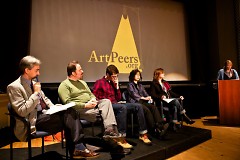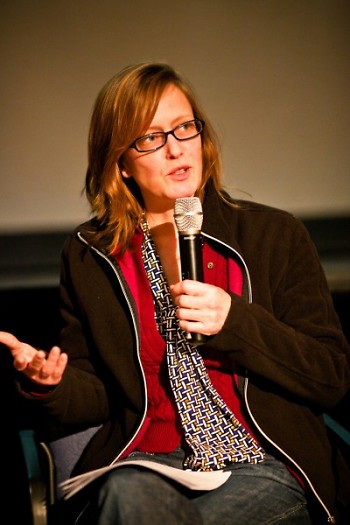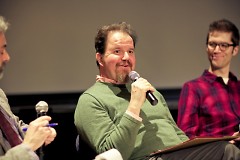Last night, UICA's Director of Education Elizabeth Goddard participated in a panel discussion concerning Art Criticism that was hosted by the Arts Council of Greater Grand Rapids, Dwelling Place and ArtPeers at Wealthy Theatre. The other participating panelists were Performance Artist, Ritsu Katsumata; Art Professor at Grand Valley State University, Paul Wittenbraker; Arts Writer for the Grand Rapids Press, Jeffrey Kaczmarczyk and ArtPrize Director of Artist Relations, Kevin Buist.
After last night's discussion, here is an afterthought from Elizabeth about the issue of art criticism:
My fellow panelists and members of the audience made many insightful comments about criticism in general. However, I felt that I personally missed an opportunity to express some thoughts concerning the differences between art criticism and thinking critically about art. The panelists were asked prior to the event to think about the term "criticism," what it means to us personally and professionally. We were also asked to speculate if the word criticism is inherently negative. I think intuitively most people would respond that yes, criticism has negative connotations. The word critic comes from the Greek word kritikos, able to discern or judge. And who likes to be judged? Not too many of us, that seems almost certain. The word judge means to determine or pronounce after inquiry and deliberation. And that’s a great thing really, because it implies that the process of inquiry and deliberation must bear some fruit prior to making a judgment.
As an educator, the process of inquiry and deliberation makes me giddy.
It seemed that some of the folks at last night’s event had some thoughts specifically about criticism and ArtPrize. One very well respected and socially engaged artist made the point that during ArtPrize many people vote for artworks that entertain through spectacle rather than speak to relevant contemporary events and issues we all face. It’s a question of value on a very broad and diverse scale, as we all have different ideas of value. The word value means identifying the relative worth, utility, or importance of something. I know I personally value artwork that references and connects contemporary issues over artwork that is steeped in traditional modes of expression without much cognitive content.
An art critic speaks from a privileged vantage point due to their education and professional experiences, but art is for everyone. It doesn’t take a lot of schooling to engage with contemporary art; it requires an openness and willingness to engage in real time and space with some materials and concepts.
One of my objectives as Director of Education at UICA is to help students and the general public use some specific strategies designed to foster critical thinking skills while engaging with contemporary art. One of these strategies is called Visual Thinking Strategies and it’s pretty basic. There are five levels of thinking visually: accountive, constructive, classifying, interpretive and re-creative.
I won’t run down this rabbit hole, but I do want to relate that the process of thinking critically about art begins by simply describing what you see. Once you can identify genre and materials and verbally describe details within the artwork, your decoding process is well underway.
Let’s face it, contemporary art is often challenging and specific “meanings” may take a little effort to understand. And yes, perhaps having an art critic respond to an exhibition prior to you seeing it may help inform you about the content and participating artists, but if you are going to spend the time and energy to view an art exhibition it is my sincere hope that you will take the time and energy to find some meaning and make some connections between the artwork, contemporary culture and how it may relate to your life’s experiences.
There is no doubt that art criticism is a highly valuable contribution to cultural dialogue. Will more of it in Grand Rapids help the general public appreciate art more? Perhaps. From my vantage point, I think greater art appreciation and engagement with the arts in Grand Rapids will truly blossom when people think critically about the art they are viewing and they identify the value as it relates to their lives and their communities.
The Rapidian, a program of the 501(c)3 nonprofit Community Media Center, relies on the community’s support to help cover the cost of training reporters and publishing content.
We need your help.
If each of our readers and content creators who values this community platform help support its creation and maintenance, The Rapidian can continue to educate and facilitate a conversation around issues for years to come.
Please support The Rapidian and make a contribution today.




Comments
I'm hesitant to believe that if when we do infact have a group of dedicated art critics in the city that enough people outside the arts community will care... We have had 12 local Sunday Soup meals (at the DAAC) now and attendance has been pathetic with a capital "P" to say the least (considering how many people i hear complaining about the issue at bars, parties, etc).
After the big news of 5x5, the DAAC (SS#11) was at full compacity at 100 people eager to help fund a local project. Then after all the hype, attendance went back to how it normally is (15-50ish people). Similarly to how when natural disaster strike, everyone wants to help, many do- but then after a month or so of hype/news coverage, everyone seems to forget and we move on to another thing.
Additionally, I do enjoy these great events (kudos to the organizers). But at many of these talks, someone always seems to make a comment publicly or under their breath that we're just preaching to the choir- which I TOTALLY agree with. With that said, I think we need begin practicing what we preach. There are too many great creative minds in the city, for all of us not to collaborate more often and find solutions to these problems.
Similar to how art critics hold artists responsible to the ideas they are working with, the public should ask of artists and their various skill sets in creating engaging visual culture. Lambert Zuidervaart noted at the Art in Public Symposium that when anyone has a skill set (like artists) they have a responsibility to share what they know with the public. Art gives so much flexibility in allowing one to adopt methods from other disciplines which allows for so many people to get involved in finding these solutions that we all seem to crave.
Enough of these discussions, round tables, and lectures have happened in the past year or so that something needs to result from them.
I for one am very eager and more than willing to take the time to collaborate with anyone who wants to on a creative project that hopefully addresses these issues.